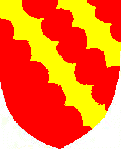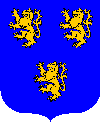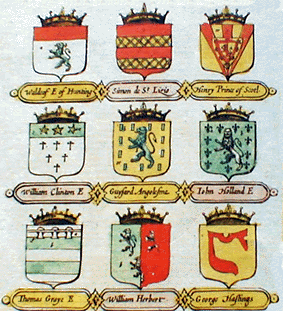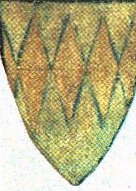Loxley & Huntingdon
Loxley
Locksleah, Locksley, Loxley are all synonymous with the claimed place-name for the birth-place of Robin. Surely then following naming patterns his name would have been Robin or Robert de Loxley?
If it can be relied upon, the 'Sloane Manuscript' of 1600 gives Robin's birthplace as Loxley. However, although the inspiration for the ballad character was granted 'Loxley' he was not born there. There is a Loxley in Warwickshire, another in Staffordshire and one in Yorkshire. Locksley/Loxley near Sheffield is reputed to be his birthplace. However there is no corroborating written record of this. If his name was Robert de Hode, could he not just as easily have been a native of Hodresfeld (Huddersfield)? or Hotham [D.B. Hode] in east Yorkshire? Just as in the words neighbourhood, knighthood or priesthood, could not the word "hood' represent a "state of being". In fact I find that the modern word 'Hood' has been completely hijacked by the allusions to hooded clothing, whilst hoods have become synonymous with criminals wishing to hide their identity. Yet the name for the inspiration of the ballad character was not Hood, Hode or Hod &c.
To confuse the issue a gravestone reputed to be a copy of Robin's
grave from Kirklees is known from Loxley in Warwickshire,
with a Lombardic style or fleuretty cross on the capping stone.
This confusion is modern conflation par excellence redolent
of some of England's finest story-tellers.
A very similar style grave cover was drawn by John Throsby from
St. Anne's Well in Nottingham which could have been sold to the
Nottingham tourist traders by the Armitage family
of Kirklees.
Loxley village in Yorkshire lies on the River Loxley about three
miles from the centre of present day Sheffield near the site of
a Roman road from Doncaster to Chapel-en-le-Frith in Derbyshire ("the
road to nowhere"). See The Last Eorl
A few miles to the west of Loxley is Hathersage, the
reputed burial place of his second-in-command, "Little John". The
Hathersage district has a number of places using the name "Robin
Hood"- Robin Hood's Stoop, Robin Hood's Cross and Robin Hood's Cave.
However, from more recent findings neither this Yorkshire Loxley, the
Staffordshire Loxley nor the
Loxley in Warwickshire are the site of one of Robyn's manor houses. The name
has been changed as they say 'to protect the innocent' and has yet to be
announced. When the present owner discovers his good fortune, he will be
well pleased and 'Time Team' or their hopefully subsequent equivalent, will have to spend more than
three days sifting the soil.
See: Robin Hood Places
 Huntington
Huntington
The earl of Huntington's arms were described by Joseph
Hunter as Gules, two bends, engrailed or. However Hunter appears
to be using earlier sources (e.g. Ritson, Major et.al.) without question.
If there were a coat of arms or an achievement then the arms would
have evolved after the invasion of 1066, as such they were introduced
by the Norman-French into England in Henry I's reign..
Further research has shown that in fact a coat of arms very similar
to the one provided above is found in the family of a traditional
adversary of the person styled 'Robin Hood', William Brewer, an early
Sheriff of Nottinghamshire and Derbyshire. The title earl of Huntington
is used by Munday in his plays but whether this refers to an imaginary
place of title or Huntington in Yorkshire, Huntington
in Staffordshire, Huntingdon in
Huntingdonshire/ Cambridgeshire or Huntingdon in Herefordshire/Worcestershire,
is not apparent. The phonetic spelling of Huntington as written in
Munday's plays and the ballad Robin Hood and Queen Katherine could
easily have been originally spelled with a "d". However it seems to be
common to spell Huntingdon as Huntington during the Tudor period.
According to one author, Robin Hood was the earl of Huntington
whose true name was Robert Fitzooth (Filii Ooth, corrupted to Robin
Hood) who was descended from a Gilbert de Gaunt, the earl of Ryme
and Lindsey [Muschamps were his stewards]. Gilbert de Gand [Gaunt/Ghent]
according to the Domesday Book, also held lands in the East Riding
of Yorkshire at Humanby, Ricstorp & Wold Newton.
The 2nd earl Warrene had two children [some sources state six],
William and Adeline. Adeline married Henry Canmore [Gaelic : Ceann
mhor] or Henry de Huntingdon [b. 1114, d. 1152] Prince of Scotland,
earl of Northumbria and Huntingdon. Prince Henry's fifth child, David
earl Lennox became the 2nd Earl of Huntingdon. One of Henry's grandchildren
[Isabella Ceann mhor] married Robert de Bruis [Bruce] of Scotland. The
title earl of Huntingdon was not lost to the [Ceann mhor] Canmores with
David's death in 1219 at Yardley [Northamptonshire] for his youngest
child John Ceann mhor inherited the title. However with John's death,
the Huntingdon honour was eventually broken up in 1245 when John Le Scot's
wife died. Earl David was succeeded by two daughters, for his eldest son
Robert, who some have equated with "Robin Hood" died at about the age of
thirty in 1221. Both Robert and John pre-deceased their two sisters,
Ada and Isabella. The title could then have passed through Ada to the Hastings
family but the title earl of Huntington was went into abeyance until granted
to William Clinton [Fiennes] of Climpton, Oxfordshire
by Edward III for his assistance against the Scots.
|
Arms of Fiennes: Azure, three lions rampant or . 
|
Thus the title earl of Huntingdon was taken from the Scottish line. Jean/John le Scot/Cean mhor, earl of Chester and Huntingdon was probably the the last in the Ceann mhor Scottish line to hold the title. Thus if there were a dispossesion of the earldom then this is where it definitely occurred. See: The Earls of Chester.
In the pedigree of the Scottish kings there is a Robert of Huntington [born before 1207 perhaps 1180]. He appears to be the eldest child of seven, of David Earl Lennox [2nd Earl Huntingdon]. This would appear to be Huntingdon in what is now Cambridgeshire but was then Huntingdonshire. Robert's mother was Mathilda [Maund/Maud] of Chester, Countess de Keveliock [Ceuelioc, Wales] whose father Hugh, was the earl of Chester. Coincidentally the first reference to the ballads of Robin Hood is titled 'Rymes of Robyn Hood and Randolf Erl of Chestre' Thus this Robert should have inherited the title "Earl Huntingdon" but because he pre-deceased his father he did not aquire the title. According to Fordun, Robert Ceann mhor died in infancy. Robert's younger brother Jean le Scot appears to have inherited the title "Earl of Huntingdon" as well as the earldom of Chester. Interestingly, the 6th child of David and Mathilda was Isabella Ceann mhor [FitzDavid] of Huntingdon who married Robert Bruce, 4th Lord of Annandale which led to the line of Bruces including the great Robert le Bruis I King of Scotland.[note: Bruis, like other titled Scottish family names is in fact French!#].
Pedigree for the earls of Huntington*:
Malcolm III ===============St. Margaret Aethling Waltheof II=========Judith de Boulogne "Canmore" | Queen of England Earl of Huntingdon King of Scotland | | David I King of Scotland=====2<=====Matilda [Maud] of Northumberland, daughter & heir of =====>1=====Simon I de St. Liz | Waltheof II of Northumberland Earl of Huntingdon Queen of Scotland b.Huntingdon abt. 1074 | Henry Ceann mhor=========Ada, Adeline Warrene, daughter of William de Warrene 2nd Earl Warrene. Prince of Scotland & Countess Warrene 2nd Earl of Northumberland | Earl of Huntingdon | David Earl Huntingdon, Earl Lennox.========= Mathilda [Maud] of Chester, Countess de Kevelioch | | _____________________________Ceann mhor______________________________________________________ ____ | | | | | | Robert of John le Scot Marguerite==Alan Ada=====Sir Henry Isabella====Robert Henry Huntingdon de Huntingdon of Galloway Hastings Bruce of Stirling 1191-1221 Earl of Huntingdon [illegit.] Earl of Chester | | John Baliol=====Devorguilla | | | Balliol line Hastings line Bruce line * Indeed there is a connection to Robyn here but it is very, very distant. |
From the above pedigree it can also be noticed that Sir Henry de Hastings
married into the Canmore [Gaelic: Ceann mhor or "bighead"] family
which at that time lay claim to the title earl of Huntingdon, his
line ostensibly could have succeeded to the title earl of Huntington
but it was granted by Edward III in 1337 to William Fiennes for services
offered in the Scottish Wars.
Later Lord William Hastings
was the king's Captain of the Wool Staple at Calais [during Edward
IV's reign] and was given the title Tyger Pursuviant of Calais.
It is this tyger which sits on the Midgley achievement
of arms and indicates a follower of Lord William Hastings created
a peer by Edward IV on the battlefield of Towton in 1461. Edward the
IV was of the Yorkist line, Lord Hastings his great friend and warrior
in arms was beheaded in 1483 by another Yorkist, Richard III, following
Edward IV's death.
See Richard Neville,
Earl of Warwick
Not shown in the pedigree above is the fact that another son of Henry Prince of Scotland, Malcolm IV ["The Maiden" reigned 1153-1165] was given the title of "The 6th earl of Huntingdon"4 Henry II had insisted that he surrender his claim to Northumbria in 1157 in return for a re-grant of the earldom of Huntingdon. Malcolm fought as an English baron in 1159 against the French and did homage to the English king in 1163. Between 1160 and 1164 Malcolm was busy suppressing rebellions in Scotland.
Even earlier, Maud [Matilda] of Huntingdon, had married David I,
King of Scotland secondly but firstly, Simon de St. Liz an earl of
Huntingdon. Maud was Waltheof II's daughter who was created
earl of Huntington under William the I. Maud and Simon I had
a son Simon II who according to the map-maker John Speed inherited
the title earl of Huntington [Speed uses the spelling in both ways]
through his mother. Speed says that Maud's son, Henry Ceann mhor by
David I of Scotland carried away the honour after the death of her husband
Simon I from his half and elder brother. However Prince Henry pre-deceased
his father, David I and by "mutability of fortune and favour of
princes, dignity was again restored to the de Lizours [sic] and against
the Scottish"3 So here again we have a case of dispossesion
of the earldom of Huntingdon.

|
WHY HUNTINGTON?
From the above pedigree we may be able to see that Matilda
of Northumberland was possibly born here at Huntington, Yorkshire.
This may indicate that Waltheof's Court was here or nearby,
outsideYork, Eorfwich or Euric. There also appears to be a hall of
Waltheof's at the lost place of Hallam in South Yorkshire.
Waltheof was an important Anglian leader from Northampton
in Northumberland who due to his young age was superceeded as leader
of the English by Harold Godwinson of Wessex whose son led
the English at the Battle of Hastings. Waltheof was later defeated
by William I of England. The "Harrying of the North" between Tyne and
Tees removed this warriors' army from contention when every male over
the age of 15 was butchered for rebelling against the Norman invaders.
Was this the origin for the Robin Hood dispossession of Munday's "Earl
of Huntington", for Waltheof would appear to have been the Anglian Earl
of Huntington in Yorkshire.
Huntington manor in North Yorkshire lies today in the N.E. outskirts
of York city. York was the Primary Cathederal in England until William
I moved this hierarchy to Canterbury under a Norman Bishop. Huntington
Manor would have played an important part in food production
for the city and guarded the northern approaches to the city wall
and gate.  In the Domesday book of 1086 Huntington is referred to
as Huntingdune [HVNTINGDVNE] but by 1579 Christopher Saxton has
it spelled Huntington as does John Speed in
1610 who also distinguished Huntingdonshire as Huntingdonia. By
Thomas Moule's time the spelling of Huntington in Yorkshire had retained
its spelling of Huntington.
In the Domesday book of 1086 Huntington is referred to
as Huntingdune [HVNTINGDVNE] but by 1579 Christopher Saxton has
it spelled Huntington as does John Speed in
1610 who also distinguished Huntingdonshire as Huntingdonia. By
Thomas Moule's time the spelling of Huntington in Yorkshire had retained
its spelling of Huntington.
| Maps from various authors
which indicate that the spelling always varied for Huntingdon in Southern England but never varies for Huntington near York after Domesday.
There are of course other places with the name Huntingdon/Huntington: 1. Huntingdon [Herefordshire/Worcestershire] referred to by Speed as Huntington Chapel. 2. Huntington, Staffordshire. West of Cannock Chase. See Hood Statistics 3. Huntington Lothian, Scotland. Between Dunbar and Edinburgh. |
In the DB Huntingdune near York consisted of two carucates
and six bovates [taxable] and land for two ploughs which was held
by Frithgestr & Arngrimr, [both Danish names] from King William
I himself.
The DB also states that Thorketill & Thormothr [Danish
Sokemen] held two manors of 5 carucates, taxable, with three ploughs
possible. It is mentioned that "now Nigel [ Nigel de Fossard,
under-tenant of Count of Mortain] has it from the Count [ the term Count is
French] in lordship - half a plough, a priest & church,
8 villagers with one plough."
The whole manor was 7 furlongs by 7. The value had dropped
as with other properties after "The Harrying of the North" from
20 shillings before 1066 to 12 shillings in 1086 or to put it into
perspective, by 40%. See: Domesday Book Defined
Munday's plays The Death of Robert Earle of Huntington & The Downfall of Robert Earle of Huntington have striking correlations with persons in history. These names are all associated with French-Norman family names in the North of England, indeed if Robin is a contraction of Robert then this is a particularly Norman name:
*Sir Hugh Lacy [Hugh Lacy
Lord of the manor of Midgley] The de Lacis were granted large estates in Yorkshire.
*The Earl of Chester [Hugh Keveliock, Earl of Chester
& his grandson Jean/John le
Scot who also took the title Earl of Huntington]
*Lord Fitzwater [Fitzwalter]
*Sir Doncaster of Hothersfield [Huddersfield]
*Justice Warman [Warrene?]
*Earl of Leicester [Roger de Beaumont 1st earl Leicester
married Isabel deVermandois]
who married secondly, William 2nd earl de Warrene
who held the manor
of Wakefield]
*Hugh de Brun [Hugh le Brun married Maud de Albini
dtr. of Duke of Norfolk, his
daughter, Alice, married John 7th Earl Warrene]
*Henry de Burgh [Elizabeth de Burgh married Robert
Bruce of Scotland in 1302]
*Aubrey de Vere [Joan de Vere entered the Warrene
line by marrying William de Warrene
who pre-deceased his father, dying in 1286]
*Bruce [Robert Bruce married into the Earl of Huntington
generation]
Place names also have actual places in the North [line numbers refer to The Downfall of Robert Earle of Huntington by Munday]:
Sowtham [Southowram near Halifax], line 284
Hothersfield [Huddersfield], line 284
Wortley [South Yorkshire], line 284
Bairnsdale [Barnsdale], line 1282
Barnsley, line 1286
Rotheram [Rotherham], line 1292
Wakefield
Bawtrey [Bawtry] South Yorkshire, line 2496, a river
port prior to fen draining in the 1700's.
In addition:
The Greenwood, lay near Heptonstall, West Yorkshire.
[from which many local people take their surname] Guisborough
in Cleveland which originally lay in Yorkshire, was once held by the
Bruce family & according to John Bellamy was called Gisburne
in the medieval period. [GISBVRGH in Christopher Saxton's map
of 1579 and also in John Speed's map of 1610]. Certainly Munday
could have used the name with slight modification. Guisborough became
the seat of the Chaloners. See Stanley Page
Whether Munday was using unknown ballads or other sources as well
as the Geste is not known but there is certainly a good sprinkling
of recognisable Yorkshire names along with his 'grene wode' mentioned
many times. The Geste, which I can show was the original Robin Hood
ballad, never mentions 'Shirewode' or even 'Sherwood'. This was a
later addition to the Robin Hood ballads, again 'fact' has been constructed
upon fallacy, the Geste author did not only have the forest of Sherwood in
mind particularly when he penned his cryptic political song.
In addition Munday has Gilbert de Hood as Robert's uncle who
is the Prior of York1. Gilbert Hoode is also described in
a play from 1600 as Robert's father2
In the late 1500's and early 1600's Huntington was the
estate of the earls of Northumberland. The Percy's throughout the
medieval period arguably possessed as much power and baronage as the
English kings and were a common source of irritation for the crown.
The 9th earl, Henry Percy who was a Catholic was imprisoned in the
Tower of London for his suspected role in the "Gunpowder Plot" in
1605.
Further recent research does not support
the idea that Robyn was ever an an earl. However, I find that the man who
modelled for the ballad character had some astounding connections which have
yet to be announced.
Note:
# De Ballilleul s= Balliol [Baliol] from Picardy10
De Bruce = Bruis/Brus [Fr.]11
Fraser = Freseliene, from Anjou11.
Grant = Fr. nickname Le Grande11.
Hay = from the Cotentin11.
FitzAlan = Picardy10 took the name Stewart = hereditary office of the steward of Scotland. The first steward of Scotlandwas Walter FitzAlan who was descended from a long line of Breton nobles who were hereditary stewards of Dol in Brittany11. It was imperative of course that the steward who was responsible for the king's household could be absolutely trusted, they had the responsibility for over-seeing the prepararation of food to ensure it was not poisoned. The name underwent a spelling modification in the form of 'Stuart' which enabled a more correct French pronunciation for the allies of Scotland.
Sources :
1. Munday, Anthony. The Downfall of Robert Earle of Huntington.[pdf]
2. Look About You, 1600.
3. Speed, John. The Counties of Britain, 1610.
4. Hallam, Elizabeth [Gen.Ed.] The Plantagenet Encyclopaedia, Tiger Books, London, 1996.
5. Moule, Thomas. The County Maps of Old England, 1830.
6. Wildey,George. Map of the British Isles, 1715.
9. Domesday Book for Yorkshire.
10. Fry, Plantagenet, Somerset. Kings & Queens, Dorling Kindersley, 1990.
11. Andrews, Allen. Kings & Queens of England & Scotland, Marshall Cavendish, 1976.
Copyright © Tim Midgley 2000 internal links revised July 2023.